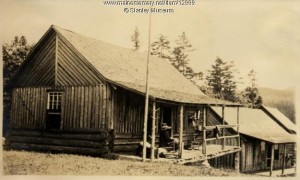Sporting camps are a traditional feature of Maine’s wildlands which function primarily as destinations for primitive recreation and some motorized activities such as boating and snowmobiling.
By the Commission’s definition, sporting camps are distinguished from other recreational facilities in that they are destinations, rather than transient lodging facilities or bases of operations for activities in another location. Sporting camps must also have a resident on-site attendant available full-time to meet the needs of guests and must not exceed 10,000 square feet of total floor area for all principal buildings associated with the facility.
There are serious challenges facing the sporting camp industry today. As a result of increased road access to more remote areas, the quality of hunting and fishing has declined. Also, the younger population appears to have a declining interest in hunting and fishing, and thus sporting camps are seeing a drop in hunting and fishing guests. Spiraling land values in many parts of the jurisdiction make financing sporting camp operations very difficult.
To address some of these challenges, sporting camps are now trying to focus more on nature-based activities, such as canoeing, hiking, and bird-watching, to fill off-season times and to offset the decline in hunting and fishing guests. Sporting camp owners are finding that amenities sought by guests who participate in nature-based activities are different than those of the past, and are trying to adapt to new expectations.
Sporting camp owners are very dependent on the natural resource and remoteness values in their immediate vicinity. Maintenance of relatively pristine surroundings is essential to most of the camps in attracting and maintaining clientele. Thus, one of the greatest challenges facing sporting camps is the instability brought on by changes to land ownership.
Such changes raise questions as to whether the features upon which sporting camps depend – a remote landscape, high-value natural resources, and the tradition of open access to private lands – will continue.
As a result of these and other factors, the number of operating sporting camps within the jurisdiction has dwindled over the past 50 years to the point today where fewer than 40 traditional camps operate.
Considering their cultural value and compatibility with remote recreational settings, a basic question is whether the Commission’s policies and regulations are adequately supportive and protective of these facilities.
The Commission has at its disposal a number of mechanisms that can help protect sporting camps. Recognizing a sporting camp’s dependence on its remote setting and the sensitivity of many sporting camps to intrusions from other intensive uses, the Commission maintains that isolated patterns of development in remote locations, such as sporting camps, should not be used as the basis for rezoning adjacent lands for development.
Likewise, the Commission will evaluate not just rezoning petitions but any development proposals within the immediate vicinity of any existing sporting camps with particular care in order to ensure that the recreational and cultural values that sporting camps offer are protected from incompatible land uses.
Given the small number of sporting camps and large number of people for whom they provide recreation, the Commission also gives special consideration to sporting camps in its development standards. Such consideration includes allowing in-place reconstruction of nonconforming sporting camps and permitting guest cottages associated with new sporting camps to meet the dimensional requirements of private residences rather than commercial structures.
Although the Commission’s approach to sporting camps is generally sound, one significant issue remains. Sporting camps in existence prior to 1971 have been zoned General Development (D-GN). As the challenges facing sporting camp operations increase, so does the potential for conversion or expansion of sporting camps to facilities or uses that are more intensive or less compatible with remote values (such as condominiums, family compounds or large-scale resorts). Although new sporting camps are today allowed in most Development and Management Subdistricts, as well as by special exception in many Protection Subdistricts, the appropriateness of the present General Development (D-GN) zoning of sporting camp facilities, particularly those in more remote settings, must be seriously reexamined.


